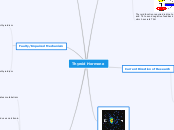Thyroid Hormone
Basics
Two very similar hormones from amino acid tyrosine
Triiodothyronine (T3) - three iodine atoms
Thyroxine (T4) - four iodine atoms
Thyroid mainly secretes T4 - cells convert most
into T3
Regulates homeostasis and development
maintain normal blood pressure, heart rate, digestive function
Vertebrates need thyroid hormones for bone-forming cells
and nerve cells during development

Thyroid function required iodine to synthesize T3
and T4 to send negative feedback to pituitary gland,
which secrets TSH
Current Direction of Research
Possible link between thyroxine and deterioration of eyesight in elderly people (AMD)
experimented on mice
no alpha-1 receptor: low body temperature,
mild cardiac malfunctions
mild disruption of entire beta gene: deafness,
elevated TSH
beta-2 disruption: normal hearing, elevated TSH
lacking both alpha isoforms: died within first few weeks
discovered that higher levels of free thyroxine
mean increased risk of AMD
People with hyperthyroidism have highest risk
of AMD
excess of thyroid hormones seem to
accelerate deterioration of cones in the retinas
Future work - scientists research effects of long-term
suppression of TSH (thyroid stimulating hormone) on AMD
Thyroid Scan
Cell Signaling Pathway
Mammalian thyroid hormone receptors consist of:
~alpha-1 gene ~beta-1 gene
~alpha-2 gene ~beta-2 gene
Receptors:
~trans activation domain
~DNA binding domain
~ligand-binding and dimerization
*BIND TO SEQUENCES OF DNA
(T3 RESPONSE ELEMENTS [TREs]*

Ligand-free State

Ligand-bound State
How the Thyroid Hormone Works
Faulty/Impaired Mechanism
Too much hormone secretion - hyperthyroidism
High body temperature, sweating, weight loss,
high blood pressure, irritability
Graves' disease - autoimmune disorder - immune system produces antibodies that activate thyroid hormone production
Too little hormone secretion - hypothyroidism
Mutations in the receptor beta gene abolish ligand binding
Individuals with this mutation show type of hypothyroidism
characterized by goiter, elevated T3 and thyroxine,
normal/elevated TSH
Affected children show attention-deficit disorder
Is a dominant trait
Cannot keep pituitary gland from secreting TSH -
leads to enlargement of thyroid gland and swelling
of neck (goiter)
Correct Mechanism
Regulates metabolism
Produces calcitonin
helps control blood calcium levels
Regulating Calcium Levels in Animals
Produces and Releases
-Triiodothyronine (T3)
-Thyroxine (T4)
Triiodothyroine (T3)
affects almost every physiological process in the body, including growth and development, metabolism, body temperature, and heart rate.
Thyroxine (T4)
the inactive form and most of it is converted to an active form called triiodothyronine by organs such as the liver and kidneys.
Negative Feedback
Diagram of Negative Feedback Loop
TRH (Thyroid Releasing Hormone) stimulates TSH
TSH (Thyroid Stimulating Hormone) then receives
the signal and stimulates Thyroid Hormones.
At the end, both TSH and TRH shut down
and the loop starts over again.
